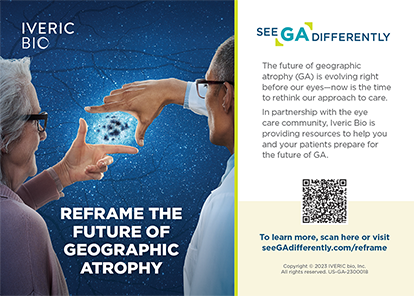Aug 2005
Acular LS Coupled With Restasis
Combination therapy can increase patients' comfort.
Barry A. Schechter, MD
Dry eye disease affects up to 20% of adults aged 45 years or older.1 Although patients across the age spectrum are affected, dry eye is more prevalent in women, especially in the perimenopausal age group. A recent study reported that dry eye disease affects more than 3.2 million American women who are middle-aged or older, with the prevalence increasing as the populace ages.2
Dry eye disease is caused by inflammation mediated by activated T-cell lymphocytes.3 Infiltration of the conjunctiva and lacrimal gland occurs,4 and the resulting damage may be irreversible. Despite the availability of numerous tear substitutes, many of these patients experience corneal pathology and may complain of poor vision.5
Cyclosporine ophthalmic emulsion 0.05% (Restasis; Allergan, Inc., Irvine, CA) has been shown to significantly reduce the number of activated T-lymphocytes within the conjunctiva,6 thereby suppressing the inflammation that causes dry eye. Restasis increases tear production and improves the quality of naturally produced tears. Restasis is the only therapeutic agent approved by the FDA for the treatment of chronic dry eye. In a large randomized trial, topical cyclosporine A 0.05% was reported to significantly improve the signs and symptoms of dry eye disease in patients with considerable aqueous deficiency and keratoconjunctivitis sicca.7
Topical cyclosporine has been shown to be safe for long-term use and to provide high levels of patient satisfaction.7-9 The most commonly reported side effect with cyclosporine therapy is a stinging sensation upon instillation at the commencement of therapy. This initial discomfort during the induction phase of cyclosporine therapy usually subsides with continued dosing, so clinicians should encourage patients to continue the therapy in order to reduce the risk of irreversible ocular damage secondary to chronic inflammation. Dry eye patients are frequently symptomatic, and they may complain of burning and stinging of their eyes.
Ketorolac ophthalmic solution, a topical NSAID drop, has been shown to reduce ocular pain associated with cataract and refractive surgery and has a favorable safety profile.10,11
In an attempt to make my dry eye patients more comfortable, I conducted a study to determine if the concomitant use of ketorolac tromethamine ophthalmic solution 0.4% (Acular LS; Allergan, Inc.), improved patients' comfort during the initiation of topical cyclosporine A for the treatment of chronic dry eye disease and increased patients' comfort while awaiting the clinical effects of cyclosporine.12
PILOT STUDY
Methods
This single-center, randomized, 6-week, open-label clinical trial included 52 patients with clinically diagnosed dry eye. Each patient was randomized to receive either cyclosporine A 0.05% b.i.d. or an adjunctive regimen of ketorolac tromethamine 0.4% b.i.d. followed by instillation of cyclosporine A 0.05% 10 minutes later. The patients were evaluated at three study visits: baseline, week 2, and week 6. At each visit, investigators performed corneal staining and assessed patients' ocular comfort level, which was subjectively measured on a four-point scale (1 = mild discomfort,
4 = severe discomfort). The severity of dry eye in these patients was measured using the Ocular Surface Disease Index, an FDA-approved dry eye questionnaire, Schirmer's (with anesthesia) scores, and tear break-up time tests. Changes from baseline readings were recorded at weeks 2 and 6, and patients' final determination of the success of the treatment regimen was evaluated at week 6.
Key Patient Inclusion Criteria
Patients 18 years of age or older who had a clinical diagnosis of dry eye were eligible to participate in this study. Written informed consent was obtained prior to performing any study-related procedure. Patients with known sensitivity to cyclosporine, ketorolac, or any component thereof were excluded. Patients who had a condition that, in my opinion, might put them at significant risk or interfere with their participation were also excluded. Patients with a history of rheumatoid arthritis were excluded.
The cyclosporine subgroup included 27 patients, and the combination cyclosporine and ketorolac group included 25 patients. The mean ages were 68.0 years and 66.3 years, respectively. The first group included five males and 22 females, and the second group included seven males and 18 females.
RESULTS
Ocular Comfort
Both treatment regimens provided statistically significant improvements in ocular comfort at all follow-up study visits (P<.001). At each follow-up visit, the adjunctive regimen of ketorolac with cyclosporine provided a greater improvement in ocular comfort compared with cyclosporine monotherapy (Figure 1).
After 6 weeks of therapy, patients using adjunctive cyclosporine/ketorolac continued to have greater improvements in their mean ocular comfort scores compared with patients using cyclosporine alone (mean improvement of 2.55 ±0.95 points with the adjunctive regimen, compared with 1.53 ±0.91 points with monotherapy [P=.309]).
Corneal Staining
Both treatment regimens showed statistically significant reductions in corneal staining at every follow-up study visit (P<.001). At each visit, the adjunctive regimen of cyclosporine/ketorolac provided a greater mean reduction in corneal staining compared with cyclosporine monotherapy. The mean reduction in corneal staining was 1.74 ±0.9 with cyclosporine/ketorolac, compared with 1.27 ±0.56 with cyclosporine monotherapy (Figure 2).
Ocular Surface Disease Index
Mean improvement in ocular surface disease index scores was greater in the cyclosporine/ketorolac group than in the cyclosporine monotherapy group. The mean reduction score was 23.85 ±21.42 points with cyclosporine/ketorolac and 15.03 ±11.99 points with cyclosporine monotherapy. This difference showed a trend toward statistical significance (P=.096) (Figure 3).
Other Outcome Measures
There were no significant between-group differences in the mean change in Schirmer's scores or tear break-up tests after 6 weeks of treatment (P=.591). The adjunctive use of ketorolac with cyclosporine during the initial induction phase of therapy reduced patients' phone calls to my office compared with cyclosporine monotherapy. The latter patients complained of burning or discomfort.
DISCUSSION
In the aforementioned study, the addition of ketorolac to cyclosporine during the first few weeks of treatment significantly heightened patients' comfort. Patients treated with the adjunctive regimen had notably greater improvements in their mean corneal staining scores and larger reductions in their ocular surface disease index scores than those treated with monotherapy, in part due to patients' improved comfort resulting from their concomitant use of ketorolac. Ketorolac was proven to be safe, with no adverse corneal events during the 6-week trial.
Many clinicians are hesitant to prescribe topical NSAIDs for long-term use because of prior reports of corneal melting.13 The demonstrated safety of ketorolac throughout the 6-week duration of this study suggests that this drug may be safe to use in dry eye patients when coupled with the use of topical cyclosporine.
The greater mean improvements in ocular signs and symptoms in the adjunctive group are likely due to the increase in patients' comfort provided by ketorolac, which enhanced their adherence to the prescribed cyclosporine regimen. Patients who are more compliant with their cyclosporine regimen would be expected to have the greatest improvements in the signs and symptoms of dry eye.
The adjunctive use of ketorolac 0.4% with cyclosporine decreased the number of patients' phone calls and unscheduled office visits compared with patients using cyclosporine alone. These decreases resulted in substantial reductions in office staff and physician time, resulting in cut costs and increased patient satisfaction.
The analgesic properties of NSAIDs may prove to be a viable alternative to topical steroids during the induction phase of Restasis. Further studies with larger numbers of cohorts are recommended.
Barry A. Schechter, MD, is Director of the Department of Cornea and External Diseases at the Florida Eye Microsurgical Institute in Boynton Beach. He states that he does not hold a financial interest in any of the products mentioned herein. This study was funded by an unrestricted grant by Allergan, Inc. Dr. Schechter may be reached at (561) 737-5500;
barrys_@hotmail.com.
1. Brewitt H, Sistani F. Dry eye disease: the scale of the problem. Surv Ophthalmol. 2001;45:199-202.
2. Schaumberg DA, Sullivan DA, Buring JE, Dana MR. Prevalence of dry eye syndrome among US women. Am J Ophthalmol. 2003;136:318-326.
3. Perry HD, Donnenfeld ED. Topical 0.05% cyclosporine in the treatment of dry eye. Expert Opin Pharmacother. 2004;5:2099-2107.
4. Pflugfelder SC. Antiinflammatory therapy for dry eye. Am J Ophthalmol. 2004;137:337-342.
5. Guerrissi JO, Belmonte J. Surgical treatment of dry eye syndrome: conjunctival graft of the minor salivary gland. J Craniofac Surg. 2004;15:6-10.
6. Kunert KS, Tisdale AS, Stern ME, et al. Analysis of topical cyclosporine treatment of patients with dry eye syndrome: effect on conjunctival lymphocytes. Arch Ophthalmol. 2000;118:1489-1496.
7. Sall K, Stevenson OD, Mundorf TK, Reis BL. Two multicenter, randomized studies of the efficacy and safety of cyclosporine ophthalmic emulsion in moderate to severe dry eye disease. Ophthalmology. 2000;107:631-639.
8. Cross WD, Lay LF Jr, Walt JG, Kozma CM. Clinical and economic implications of topical cyclosporine A for the treatment of dry eye. Manag Care Interface. 2002;15:44-49.
9. Small DS, Acheampong A, Reis B, et al. Blood concentrations of cyclosporine A during long-term treatment with cyclosporine A ophthalmic emulsions in patients with moderate to severe dry eye disease. J Ocul Pharmacol Ther. 2002;18:411-418.
10. Price MO, Price FW. Efficacy of topical ketorolac tromethamine 0.4% for control of pain or discomfort associated with cataract surgery. Curr Med Res Opin. 2004;20:2015-2019.
11. Solomon KD, Donnenfeld ED, Raizman M, et al. Safety and efficacy of ketorolac tromethamine 0.4% ophthalmic solution in post-photorefractive keratectomy patients. J Cataract Refract Surg. 2004;30:1653-1660.
12. Schechter BA, Wittpenn JR. Evaluation of ketorolac (Acular LS) during the induction phase of cyclosporine A (Restasis) therapy to improve patient comfort. Invest Ophthalmol Vis Sci. 2005;46:E-Abstract 2033.
13. Flach AJ. Corneal melts associated with topically applied nonsteroidal anti-inflammatory drugs. Trans Am Ophthalmol Soc. 2001;99:205-210; discussion: 210-21


